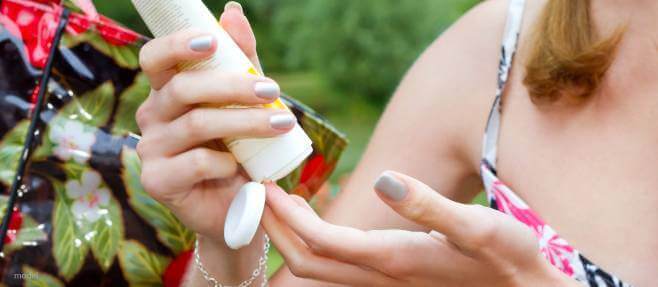Can Sunscreen Go Bad? Here’s How to Tell

In the midst of summer, many of us will undoubtedly find ourselves reaching for a sunscreen at the back of our closet or bottom of our beach bag. While wearing sunscreen daily is essential, using an expired sunscreen can actually be detrimental. Before you reach for that leftover bottle sunscreen from last year, keep reading to learn why you may want to opt for a new one!
Sunscreens Can Expire
Like any other skin care product, sunscreen can expire. Fortunately, the FDA vigilantly regulates sunscreen for both efficacy and safety. Under current guidelines, all sunscreens are required to maintain a certain minimum level of efficacy for at least three years.
Obviously, the easiest way to tell if your sunscreen is expired is to check the expiration date on the label. If yours does have an expiration date, you can rest assured it’s good until then. If that date has passed, throw it out.
Not all sunscreens provide a clear expiration date on the product itself. In these instances, it’s a great idea to use a permanent marker to write the date of purchase on the bottle. Since you cannot be sure how old the sunscreen is when you purchased it (some products can sit in warehouse for a year or longer), it’s best not to keep unmarked sunscreen beyond 1-2 years.
Which Lasts Longer? Chemical vs Physical Sunscreen
Chemical sunscreens work because many their formulations contain unstable molecules. Ingredients like oxybenzone, avobenzone, octisalate, homosalate, octocrylene, or octinoxate break down over time and become less effective. Additionally, added ingredients common to chemical sunscreens like emulsifiers can break down even faster. What was once an SPF of 50 will be much less after three years have passed. This is why its important to not use chemical sunscreen after its expiration date
While the mineral ingredients in physical sunscreens last longer than chemical formulations, the lotion or additional ingredients they’re suspended in may reach an expiration date, making the sunscreen’s application spotty or ineffective.
For a more in-depth comparison of chemical vs physical sunscreen see this blog post
How To Tell If A Sunscreen Is Expired
While going by the expiration date is ideal, some sunscreens can also go bad long before the expiration date if they stored incorrectly. Others will not have a clear expiration date on the label. Here’s who to tell if a sunscreen is bad:
Check for Changes in Color or Texture
Sunscreens that go bad experience changes in their color or texture. Sunscreens that seem more oily or watery, the ingredients appear separated, or it comes out in clumps are probably expired. If you notice any of those changes it may be time to opt for a new bottle.
Check for Changes in Smell
Handling sunscreen with dirty hands or leaving it open can invite in bacteria. Bacterial growth often gives sunscreen an odd smell. This may or may not render the SPF inactive, but it can increase the risk of sunscreen-related breakouts and even bacterial skin infections.
Proper Storage Make Sunscreens Last Longer
Contrary to popular belief, open sunscreens will not go bad quickly as long as you properly store it. Excessive heat and cold may make your sunscreen go bad long before it reaches its official expiration date.
It’s common to leave sunscreen in a hot pool shed or in the direct sun next to your lounge chair. But exposing sunscreen to prolonged extreme heat and the sun’s rays can quickly degrade sunscreen’s ingredients. The same goes for extreme cold. If you keep a bottle in your car year-round, just one winter freeze can make it less potent the following summer.
Always store your sunscreen at room temperature. When you’re outside, keep it in your bag or wrap it in a towel. Apply with clean hands and close the bottle tightly after each application.
What Happens if You Use Expired Sunscreen?
If it’s absolutely your only option, using expired sunscreen is typically better than using no sunscreen at all. However, sunscreen that has passed its prime will be less effective in protecting the skin from UV rays. Insufficient sun protection can lead to the following:
- Sunburn
- Sun spots
- Wrinkles
- Skin cancer development
In addition to sun damage, expired sunscreen puts you at risk for the following:
- Breakouts
- Allergic reactions
- Skin irritation
- Skin infection
To reduce your risk of sun damage, breakouts or infection, use both chemical and physical sunscreens within 3 years of purchase. Store both in closed containers at room temperature.
Daily Use Often Prevents Expiration
If you follow your dermatologist’s recommendation and use your sunscreen daily, it’s unlikely to ever expire. This includes those grey, winter days, when you’re still at risk from UVB damage.
A typical bottle of sunscreen contains 4-6 ounces. During the summer, if you apply 1 ounce to your body as recommended (approximately a shot-glass sized squeeze) you should go through a bottle within 4-6 applications. If you spend a full day at the beach, reapplying frequently as recommended, you’ll use the entire bottle in a single day.
Sunscreen can indeed last for multiple seasons if it’s been well cared for. But there’s no reason to skip out on protection in order to save. Daily sun protection not only keeps your skin looking younger, it reduces your risk of skin cancer.
Need help choosing a sunscreen? Checkout our Ultimate Sunscreen Guide and our blog post on selecting the best sunscreen for each skin type.
Disclaimer: The contents of the Westlake Dermatology website, including text, graphics, and images, are for informational purposes only and are not intended to substitute for direct medical advice from your physician or other qualified professional.
